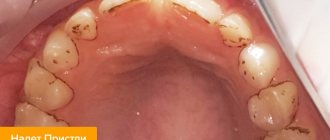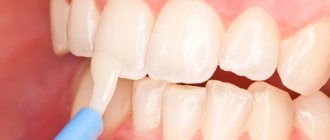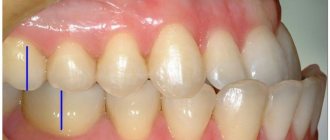Weak enamel on a child's baby teeth is not uncommon. Such teeth are still very weak, immature, and have not received enough necessary minerals. And a particular danger arises if you do not take care of baby teeth from the very first moment of eruption.
In this case, a condition called hypoplasia
- underdevelopment of tooth enamel. It can have many consequences, from thinning the enamel to completely sliding off the teeth.
In children under the age of 4-5 years, enamel hypoplasia is noticed in 30-40% of cases. This is usually painful for a child because a tooth with thin or slipped enamel reacts strongly to hot and cold, sweet and sour.
Baby teeth with underdeveloped enamel are especially at risk for bottle caries.
.
Manifestation of dental hypoplasia
Hypoplasia can be systemic or local. In the first case, the entire dentition is affected (the enamel of both milk and permanent teeth is damaged), in the second, one or more permanent teeth are damaged. Local hypoplasia is a consequence of mechanical trauma or an inflammatory process.
Clinical picture of hypoplasia:
- The appearance of white spots on the child’s teeth. Such defects are white (less often yellowish) appear on the outside of the teeth, have a clear contour, and do not cause pain.
- Underdevelopment of enamel. Grooves or depressions appear on the teeth. Pain is usually not noted, but aesthetic defects are very noticeable.
- Lack of enamel (aplasia). A rare manifestation of the disease, the most severe form. The enamel may partially or completely peel off from the teeth, exposing dentin. In such cases, a painful reaction to thermal and chemical irritants is observed.
Causes
To properly treat tooth enamel hypoplasia, you need to understand what caused it. Experts talk about the following reasons:
- due to the fact that mineral metabolism is disrupted, general metabolic processes are disrupted;
- the child has chronic somatic diseases;
- disorders in the brain during the period of 6-12 months, acute infectious diseases, toxic dyspepsia, rickets were diagnosed.
The location of hypoplasia depends on factors such as the severity of the disease that was suffered and the age of the patient.
Treatment methods for enamel hypoplasia in children
If white spots on teeth are invisible to others, they are usually not removed. But the enamel, severely affected by the disease, ceases to protect the tooth tissue, resulting in complications - increased wear of teeth, destruction of dentin up to the loss of teeth, and the appearance of malocclusions. To prevent this, timely therapy is necessary.
Procedures for the treatment of enamel hypopalsia in children:
Forms of the disease
It is worth highlighting several forms:
- The color of the enamel of those teeth that were affected changes. This form is considered the easiest, because here the size of the spots is the same, and their boundaries are clearly defined. A child or an adult does not feel any discomfort, there is no pain, and there is no reaction of the teeth to irritants of a thermal or mechanical nature. Also, such stains will not take on the color of the dye;
- the enamel has not fully developed. This form of hypoplasia is already more severe. Grooves, waves, and dots appear here. If you look closely at the surface of the teeth, you can see depressions and grooves of small or medium size. The enamel in them is smooth and dense;
- enamel is completely absent. This form of the disease is also called aplasia, but it is much less common. In some part of the tooth crown there is no enamel at all. A person experiences pain and has difficulty reacting to stimuli of thermal, chemical, and mechanical types.
How to strengthen enamel at home?
To protect the enamel from damage, it is recommended to follow a balanced diet (the diet should contain foods containing calcium - fermented milk products, almonds, hazelnuts, beans, peas, meat, hard cheeses, oatmeal and barley), and take vitamins with calcium.
Special toothpastes (for example, Vivax Dent, Elmex, ApaCare, Lacalut) and gels (ROCS, Amazing White Minerals) are also indicated.
Do not forget that the result of treatment depends on the professionalism of the dentist. On our website you can find a list of clinics that successfully treat this disease.
How to treat
Dental hypoplasia today is considered a process that cannot be cured or reversed. There are no medications that can relieve symptoms. As for the treatment of dental hypoplasia, it is usually symptomatic. It is also possible to reconstruct the tooth enamel.
If the lesions are small, then you can do nothing, since the child or teenager’s teeth will not hurt. If there is erosion on the enamel, or there are deep stains, then the tooth needs to be filled using composite materials.
If there is no enamel on the surface of the teeth, the doctor may prescribe orthopedic treatment or prosthetics. But it is very important to remember that if such a disease or symptoms are identified, it is important to initially consult a specialist. You cannot self-medicate, otherwise serious consequences may occur.
Treatment of amelogenesis imperfecta
Unfortunately, it is not possible to eliminate the hereditary factor that determines amelogenesis imperfecta. Therefore, treatment of amelogenesis imperfecta is aimed at preserving teeth for as long as possible. As a rule, tooth restoration with crowns is used. If necessary, the bite should be corrected to reduce tooth wear. The correct selection of toothpaste will help reduce hyperesthesia and improve oral hygiene.
Meet our tooth fairies and check prices.
Restoring enamel on baby teeth
Damage to the enamel of primary teeth can cause the development of dental hypersensitivity. They often violate the aesthetics of the dentition and provoke the rapid development of caries. Restoration of enamel is carried out using filling materials. This method combines simplicity, affordable cost and high efficiency. It allows you to eliminate the existing defect in the enamel layer. The service life of modern composites is several years. This is more than enough when treating baby teeth. It is worth saying that in the presence of foci of enamel demineralization and caries at the stain stage, deep fluoridation of teeth can be carried out. This preventative procedure will help make the enamel stronger and denser.
If your front teeth are worn out
Erasure of the enamel on the front teeth is the result of the physiological function of chewing. As a rule, its thinning is first observed on the incisors. Physiological abrasion initially appears on the masticatory surface cusps of premolars, molars, along the cutting edge and canine cusps. This process develops not only due to the consumption of hard foods, as this is the age norm. By the age of 60, the tooth decreases in height by a third, and only timely dental intervention can prevent this process. The following methods are best suited for this.
Enamel implantation
Enamel implantation is a relatively innovative method that allows you to eliminate the wear of the protective layer of teeth. A special feature of the procedure is the fusion of the enamel prism and implantation material at the cellular level. Therefore, restoration of the tooth structure occurs thanks to the implanted biological composition. This procedure allows you to increase the layer of enamel, which in appearance will not differ from the natural structure of the tooth.
Veneers and Lumineers
The use of ultra-thin dental onlays made from ceramics is one of the best options that can be used to reduce the thickness of the enamel on the front teeth. With the help of veneering, you can disguise visible aesthetic imperfections, due to which your teeth will look not only attractive, but also as natural as possible. Therefore, the abrasion of tooth enamel will not be noticeable to others.
The essence of this method of smile correction is that the dentist removes a small layer of the patient’s enamel, and then a veneer is fixed on the outer surface of the tooth. When installing lumineers, there is no need to prepare the tooth surface.
But, despite all the achievements of the modern dental industry, it is still worth taking care of preserving the natural enamel of teeth and preventing its thinning, so that in the future you will not have to look for alternative methods of restoration.
Tips for preventing thinning tooth enamel
It is much easier to prevent the destruction of enamel than to fight for its restoration. Therefore, we recommend that you use a few simple tips aimed at demineralization.
- After each meal, you should rinse your mouth with plain water and brush thoroughly twice a day. Important! It is best to use toothpastes or powders that contain fluoride. These products can be used by both adults and children. In addition, since 1984, WHO has recommended the use of pastes containing at least 2 g of fluorides as sources of fluoride ions.
- You need to add solid foods to your diet, such as carrots or beets. Food that contains large amounts of vitamins and minerals will also be beneficial.
- Try to reduce the amount of sweets containing fast carbohydrates.
- You should not rinse your mouth immediately after brushing your teeth - it is best to wait a couple of minutes, since the beneficial substances contained in the toothpaste need time to be absorbed.
- It is better to give preference to brushes with medium hardness, as hard bristles will not only remove plaque, but can also damage your teeth and gums.
- Massage your gums from time to time, as this is where nutrients are absorbed.
- Try to use whitening paste to a minimum, as they do not strengthen the enamel.
- Regularly go for preventive examinations to the dentist, because it is the doctor who will be able to diagnose the thinning of the enamel and take measures that will prevent the progression of the process.
Our qualified specialists will be happy to take care of your smile!
Prevention of fluorosis
The only possible way to prevent and prevent further development of fluorosis is to stop drinking water with a high fluoride content; in case of severe air pollution, move to another area. Fortunately, in Russia, only 2-3% of the population lives in areas where fluorosis is endemic (that is, in areas where the fluoride content in water can cause the development of fluorosis in children and adolescents). In the Leningrad region this is the Volkhov district.
make an appointment with a pediatric dentist online or by phone: +7(812)3310000
Reasons for the development of caries in temporary teeth
When visiting a dentist, parents are invariably interested in the reasons for the appearance of such an unpleasant disease. This is important because it helps prevent damage to new teeth. Sometimes it is enough to change eating habits and hygiene patterns so that the child forgets about fillings for a long time, and only comes to the dentist for examinations.
Causes of caries:
- Poor or insufficient oral hygiene. Food remains in the interdental space and on the enamel are an excellent environment for the development of carious bacteria.
- An unbalanced diet with a preponderance of sweets and carbohydrates - during the fermentation of simple carbohydrates, acids are formed that provoke the destruction of enamel.
- The lack of solid foods in the menu leads to a decrease in the frequency of chewing, reduces salivation and becomes a common cause of caries of primary teeth in young children.
- Long-term use of nipples, including on bottles and sippy cups, increases the risk of developing single or multiple bottle caries of the anterior milk teeth in children.
- Rickets is a pathology that provokes the destruction of dental tissues.
- Genetic predisposition of the child.
- Problems with bite – various anomalies in the formation of the dentition.
- Decreased natural immunity due to frequent acute respiratory viral infections, chronic diseases, and taking various medications.
- Damage to tooth germs in the prenatal period - due to maternal illness or neglect of health in the first trimester.











